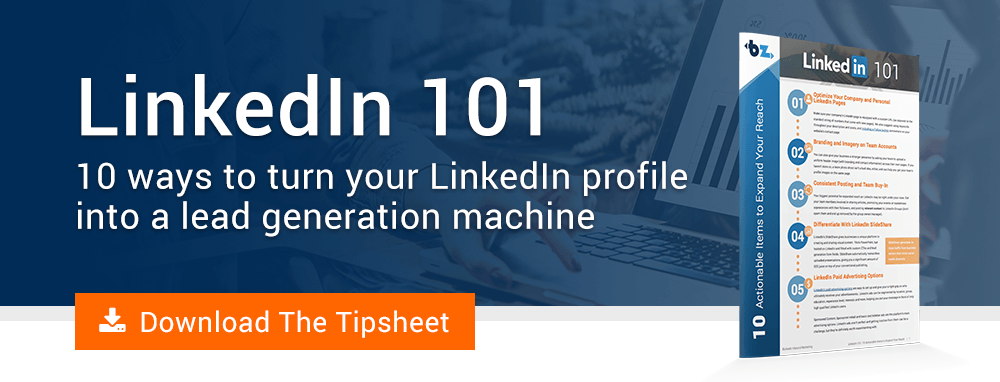Connecting with people on LinkedIn is a great way to build a strong, professional network of valuable contacts.
But in order to do this, you have to make sure that you’re connecting with the right people. Using target personas is one of the best ways to frame your search criteria and find ideal prospects.
Marketing, sales, and service teams should all be using LinkedIn to connect with different prospects and build a strong professional network for your company to collaborate with.
Why Connecting With LinkedIn Benefits Your Team
LinkedIn is a valuable professional resource that your entire team should be utilizing to build connections. Whether it’s connecting with potential clients, possible partners, mentors, or simply like-minded individuals in the same industry, building a strong LinkedIn network can open a lot of doors for your team and your company.
Connecting with LinkedIn opens pathways of communication with these different categories of people, and it can even make the difference in generating a new lead, gaining brand exposure, building a strong, mutually beneficial partnership, or finding the right candidate for a job role.
That being said, you shouldn’t be connecting with everyone in sight on LinkedIn. Remember – quality over quantity. While having a big network is great, it’s better to have a carefully tailored network comprised of individuals who are relevant to your industry and bring value.
Encourage your team to build their LinkedIn network, and you’ll quickly find yourself with a powerhouse of very valuable connections.
Why Personas Help With Building Your Network
Creating target personas is a great way to help your team determine who they should and shouldn’t be connecting with on LinkedIn. It will ensure that they’re able to follow that rule of quality over quantity within their professional network.
Creating target personas will also make the search for quality connections more efficient, as your team members will be able to narrow their search to focus on specific attributes that they’re looking for in prospects.
How to Build Personas to Identify Your Ideal Prospects
If you’ve built target personas for your content marketing strategy, then you’ve already got a good grasp on what you’re doing here. But if you haven’t, let us assure you that creating personas isn’t as hard as you might think.
Here’s a few steps to help you with the process:
1. Conduct Research
Take a look at your current list of contacts, both customers and partners, and start gathering information about them. Maybe you already have this information, or maybe it’s easily accessible via a little online research.
If not, using surveys is a great way to gather information – you can send them out in emails or even place them directly on your website. Additionally, try talking to your sales team about feedback from clients.
You should gather information such as job title, industry, company size, and location, and then focus on more psychological demographics, like pain points, goals, motivators, and challenges.
2. Organize the Information
Once you’ve collected all this raw data about your current contacts, it’s time to start analyzing it.
Look for patterns and similarities within the data, and organize it into comprehensive groups. You’re looking to build an authoritative summary of the kinds of people that your company currently works with and who you want to work with.
Ask yourself this – who is the audience of your company? Your target personas should embody this audience.
3. Apply Your Personas
Once you’ve built a few target personas, start using them to guide your search for connections. When it comes to LinkedIn search, the general professional demographics will likely be of more use.
Nevertheless, the goals and motivators that are included within each persona will help your team narrow their search even more, so they can connect the people that best match their target.
How to Connect on LinkedIn With People You Don't Know
Unfortunately, connecting with people on LinkedIn isn’t as easy as reaching out for a handshake. Regardless, it’s still possible to use the platform to network with people whom you don’t know.
Whenever you send a request to connect with someone that you don’t know, you should always send a personalized message to introduce yourself.
First and foremost, don’t try to pitch your service, product, or proposal in your first message. This will immediately feel like spam to the recipient, and will likely end up in your connection request being rejected.
The first message should be friendly and open – introduce yourself and make a note of something that you two seem to have in common, like if you went to the same university or if you follow the same influential person. Most importantly, explain why you want to connect and why it could be a mutually beneficial relationship.
Another way to connect with people you don’t know is to find prospects with whom you have a mutual contact.
When you reach out, mention this connection, and it will create a personal point of contact between the two of you. If the mutual contact is well respected and trusted, this will build your own credibility.
Go Forth and Make Friends
Ok, the goal is to make strong professional connections, but you never know – some friends could be made along the way too!
Regardless, if your team isn’t yet utilizing LinkedIn to network, these tips are a great way to help them hit the ground running.



Claire Cortese
I am a content creator here at Bluleadz. In my free time, I enjoy hugging dogs, watching reruns of The Office, and getting sunburnt at the beach.